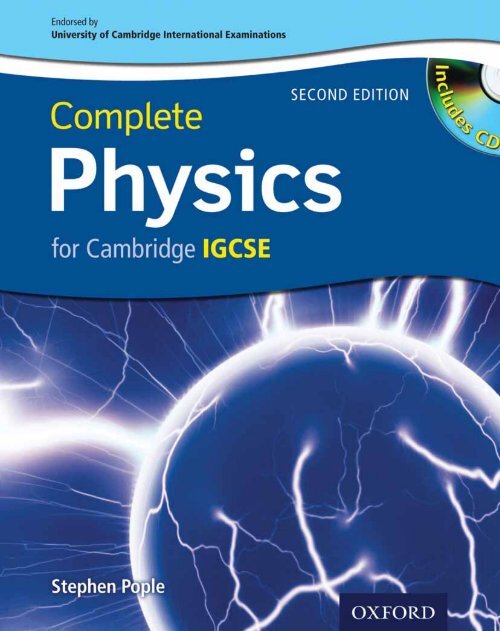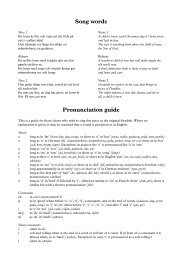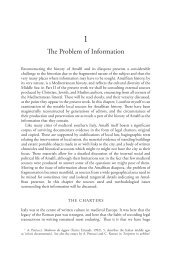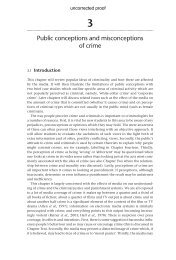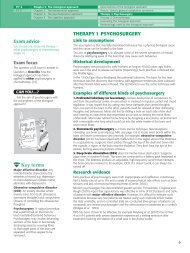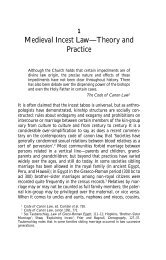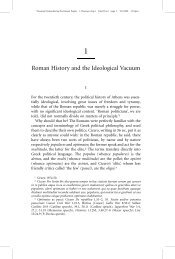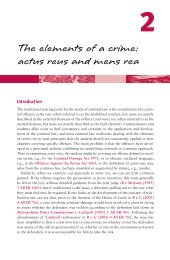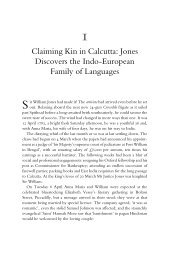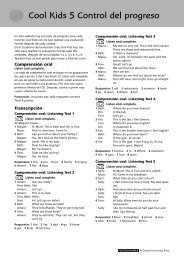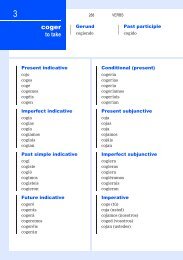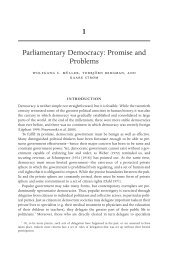Temperature (1) - Oxford University Press
Temperature (1) - Oxford University Press
Temperature (1) - Oxford University Press
Create successful ePaper yourself
Turn your PDF publications into a flip-book with our unique Google optimized e-Paper software.
Now even more comprehensive - and with a free student CD-ROM!<br />
Endorsed by<br />
<strong>University</strong> of Cambridge International Examinations<br />
This new second edition provides full coverage of the most recent Cambridge<br />
IGCSE Physics syllabus in a highly illustrative and accessible way. It also comes with<br />
a free CD to further stretch your most able pupils and provide extra support to your<br />
lower-attainers.<br />
A free student CD contains even more material to stretch your students,<br />
including revision support, past exam questions, model answers,<br />
repeated questions from the Student Books and more<br />
Full colour, student-friendly design caters to all learning types, with plenty of<br />
diagrams, charts and visuals to explain challenging concepts<br />
A step-by-step approach simplifies difficult concepts, easing comprehension<br />
Uses clear, straightforward English, ensuring clarity for your EAL<br />
students<br />
Plenty of case studies on relatable, internationally-focused issues help<br />
students understand the importance of their learning<br />
By Stephen Pople, an experienced author, written specifically for the<br />
international classroom<br />
Companion Teacher’s Guide and Revision Guide also available to provide<br />
additional support and optimally prepare students for exam success<br />
We care deeply about global access to high<br />
quality education. We collaborate closely with<br />
<strong>Oxford</strong> <strong>University</strong> <strong>Press</strong> to develop valuable<br />
resources which meet the needs of teachers and<br />
students all over the world, and are pleased to<br />
endorse <strong>Oxford</strong> resources for Cambridge IGCSE. .<br />
Ann Puntis, Chief Executive<br />
<strong>University</strong> of Cambridge International Examinations
Measurements and units<br />
1.1 Numbers and units<br />
1.2 A system of units<br />
1.3 Measuring length and time<br />
1.4 Volume and density<br />
1.5 Measuring volume and density<br />
1.6 More about mass and density<br />
Forces and motion<br />
2.1 Speed, velocity, and acceleration<br />
2.2 Motion graphs<br />
2.3 Recording motion<br />
2.4 Free fall<br />
2.5 More motion graphs<br />
2.6 Forces in balance<br />
2.7 Force, mass, and acceleration<br />
2.8 Friction and braking<br />
2.9 Force, weight, and gravity<br />
2.10 Action and reaction<br />
2.11 More about vectors<br />
2.12 Moving in circles<br />
Forces and pressure<br />
3.1 Forces and turning effects<br />
3.2 Centre of mass<br />
3.3 More about moments<br />
3.4 Stretching and compressing<br />
3.5 <strong>Press</strong>ure<br />
3.6 <strong>Press</strong>ure in liquids<br />
3.7 Hydraulic systems<br />
3.8 <strong>Press</strong>ure from the air<br />
3.9 Gas pressure and volume<br />
3.10 <strong>Press</strong>ure problems<br />
Forces and energy<br />
4.1 Work and energy<br />
4.2 Energy transformation<br />
4.3 Calculating PE and KE<br />
4.4 Efficiency and power<br />
4.5 Energy for electricity (1)<br />
4.6 Energy for electricity (2)<br />
4.7 Energy resources<br />
4.8 How the world gets its energy<br />
Thermal effects<br />
5.1 Moving particles<br />
5.2 <strong>Temperature</strong> (1)<br />
5.3 <strong>Temperature</strong> (2)<br />
5.4 Expanding solids and liquids<br />
5.5 Heating gases<br />
5.6 Thermal conduction<br />
5.7 Convection<br />
5.8 Thermal radiation<br />
5.9 Liquids and vapours<br />
5.10 Specific heat capacity<br />
5.11 Latent heat<br />
Waves and sounds<br />
6.1 Transverse and longitudinal waves<br />
6.2 Wave effects<br />
6.3 Sound waves<br />
6.4 Speed of sound and echoes<br />
6.5 Characteristics of sound waves<br />
6.6 Ultrasound<br />
Rays and waves<br />
7.1 Light rays and waves<br />
7.2 Reflection in plane mirrors (1)<br />
7.3 Reflection in plane mirrors (2)<br />
7.4 Refraction of light<br />
7.5 Total internal reflection<br />
7.6 Refraction calculations<br />
7.7 Lenses (1)<br />
7.8 Lenses (2)<br />
7.9 Camera, projector, and enlarger<br />
7.10 The human eye<br />
7.11 Electromagnetic waves (1)<br />
7.12 Electromagnetic waves (2)<br />
7.13 Communications
Electricity<br />
8.1 Electric charge (1)<br />
8.2 Electric charge (2)<br />
8.3 Electric fields<br />
8.4 Current in a simple circuit<br />
8.5 Potential difference<br />
8.6 Resistance (1)<br />
8.7 Resistance (2)<br />
8.8 More about resistance factors<br />
8.9 Series and parallel circuits (1)<br />
8.10 Series and parallel circuits (2)<br />
8.11 Electrical power<br />
8.12 Mains electricity (1)<br />
8.13 Mains electricity (2)<br />
8.14 Electrical energy calculations<br />
Magnets and currents<br />
9.1 Magnets<br />
9.2 Magnetic fields<br />
9.3 Magnetic effect of a current<br />
9.4 Electromagnets<br />
9.5 Magnetic force on a current<br />
9.6 Electric motors<br />
9.7 Electromagnetic induction<br />
9.8 More about induced currents<br />
9.9 Generators<br />
9.10 Coils and transformers (1)<br />
9.11 Coils and transformers (2)<br />
9.12 Power across the country<br />
Electrons and electronics<br />
10.1 Electronic essentials<br />
10.2 More on components<br />
10.3 Transistors (1)<br />
10.4 Transistors (2)<br />
10.5 Logic gates (1)<br />
10.6 Logic gates (2)<br />
10.7 Electron beams (1)<br />
10.8 Electron beams (2)<br />
Atoms and radioactivity<br />
11.1 Inside atoms<br />
11.2 Nuclear radiation (1)<br />
11.3 Nuclear radiation (2)<br />
11.4 Radioactive decay (1)<br />
11.5 Radioactive decay (2)<br />
11.6 Nuclear energy<br />
11.7 Fusion future<br />
11.8 Using radioactivity<br />
11.9 Atoms and particles (1)<br />
11.10 Atoms and particles (2)<br />
History of key ideas<br />
12.1 Force, motion, and energy<br />
12.2 Rays, waves, and particles<br />
12.3 Magnetism and electricity<br />
12.4 The Earth and beyond<br />
Practical physics<br />
13.1 Getting organized & working safely (Skill C1)<br />
13.2 Observing, measuring, & recording (Skill C2)<br />
13.3 Dealing with data (Skill C3)<br />
13.4 A full investigation (Skill C4)<br />
13.5 Some experimental investigations<br />
13.6 Taking a practical test<br />
Mathematics for physics<br />
The essential mathematics<br />
IGCSE practice questions<br />
Multichoice questions<br />
IGCSE theory questions<br />
IGCSE alternative-to-practical questions
5<br />
Thermal effects<br />
�� PARTICLES IN SOLIDS, LIQUIDS AND<br />
GASES<br />
� TEMPERATURE AND THERMOMETERS<br />
� EXPANSION OF SOLIDS AND LIQUIDS<br />
� HEATING GASES<br />
� THERMAL CONDUCTION<br />
� CONVECTION<br />
� THERMAL RADIATION<br />
� LIQUIDS AND VAPOURS<br />
� SPECIFIC HEAT CAPACITY<br />
� LATENT HEAT<br />
Typhoon aircraft takes off. The<br />
glow comes from hot gases<br />
in its jet engines, where the<br />
temeperature can reach more than<br />
1500 °C. At high altitudes, jet aircraft<br />
like this leave ‘vapour trails’ across<br />
the sky. However, the trails are not<br />
really vapour, but millions of tiny<br />
droplets, formed when water vapour<br />
from the engines condenses in the<br />
cold atmosphere.<br />
97
98<br />
THERMAL EFFECTS<br />
5.01<br />
� Water can exist in three forms:<br />
solid, liquid, and gas. (The gas is<br />
called water vapour, and it is present<br />
in the air.) Like all materials, water is<br />
made up of tiny particles. Which form<br />
it takes depends on how firmly its<br />
particles stick together.<br />
Solid Particles vibrate about fixed<br />
positions.<br />
Liquid Particles vibrate, but can<br />
change positions.<br />
Gas Particles move about freely.<br />
Moving particles<br />
Solids, liquids, and gases<br />
Every material is a solid, a liquid, or a gas. Scientists have developed a model<br />
(description) called the kinetic theory to explain how solids, liquids, and<br />
gases behave. According to this theory, matter is made up of tiny particles<br />
which are constantly in motion. The particles attract each other strongly when<br />
close, but the attractions weaken if they move further apart.<br />
Solid A solid, such as iron, has a fixed shape and volume. Its particles are<br />
held closely together by strong forces of attraction called bonds. They vibrate<br />
backwards and forwards but cannot change positions.<br />
Liquid A liquid, such as water, has a fixed volume but can flow to fill any<br />
shape. The particles are close together and attract each other. But they vibrate<br />
so vigorously that the attractions cannot hold them in fixed positions, and<br />
they can move past each other.<br />
Gas A gas, such as hydrogen, has no fixed shape or volume and quickly fills<br />
any space available. Its particles are well spaced out, and virtually free of any<br />
attractions. They move about at high speed, colliding with each other and the<br />
walls of their container.<br />
What are the particles?<br />
Everything is made from about 100 simple substances called elements. An atom is the<br />
smallest possible amount of an element. In some materials, the ‘moving particles’ of the<br />
kinetic theory are atoms. However, in most materials, they are groups of atoms called<br />
molecules. Below, each atom is shown as a coloured sphere. This is a simplified model<br />
(description) of an atom. Atoms have no colour or precise shape.<br />
oxygen<br />
atom<br />
hydrogen<br />
atom<br />
Iron atoms Water molecules Hydrogen molecules
Brownian motion: evidence for moving particles<br />
Smoke is made up of millions of tiny bits of ash or oil droplets. If you look at<br />
smoke through a microscope, as on the right, you can see the bits of smoke<br />
glinting in the light. As they drift through the air, they wobble about in zig-zag<br />
paths. This effect is called Brownian motion, after the scientist Robert Brown<br />
who first noticed the wobbling, wandering motion of pollen grains in water, in<br />
1827.<br />
The kinetic theory explains Brownian motion as follows. The bits of smoke are<br />
just big enough to be seen, but have so little mass that they are jostled about<br />
as thousands of particles (gas molecules) in the surrounding air bump into<br />
them at random.<br />
View through<br />
microscope<br />
zig-zag paths<br />
of smoke bits<br />
Energy of particles<br />
The particles (atoms or molecules) in solids, liquids, and gases have kinetic energy<br />
because they are moving. They also have potential energy because their motion<br />
keeps them separated and opposes the bonds trying to pull them together. The<br />
particles in gases have the most potential energy because they are furthest apart.<br />
The total kinetic and potential energies of all the atoms or molecules in a<br />
material is called its internal energy. The hotter a material is, the faster its<br />
particles move, and the more internal energy it has.<br />
If a hot material is in contact with a cold one, the hot one cools down and<br />
loses internal energy, while the cold one heats up and gains internal energy.<br />
The energy transferred is known as heat.<br />
The term thermal energy is often used for both internal energy and heat.<br />
Q<br />
1 Say whether each of the following describes a solid, a<br />
liquid, or a gas:<br />
a Particles move about freely at high speed.<br />
b Particles vibrate and cannot change positions.<br />
c Fixed shape and volume.<br />
d Particles vibrate but can change positions.<br />
e No fixed shape or volume.<br />
f Fixed volume but no fixed shape.<br />
g Virtually no attractions between particles.<br />
Related topics: energy 4.01; fusion and vaporization 5.11; atoms and elements 11.01<br />
THERMAL EFFECTS<br />
microscope<br />
lamp smoke glass<br />
cell<br />
Kinetic energy<br />
Energy because of motion.<br />
Potential energy<br />
Energy stored because of a<br />
change in position or shape.<br />
glass<br />
cover<br />
2 Smoke is made up of millions of tiny bits of ash or oil<br />
droplets.<br />
a What do you see when you use a microscope to<br />
study illuminated smoke floating in air?<br />
b What is the effect called?<br />
c How does the kinetic theory explain the effect?<br />
3 If a gas is heated up, how does this affect the motion of<br />
its particles?<br />
4 What is meant by the internal energy of an object?<br />
!<br />
99
100<br />
probe contains<br />
thermistor<br />
THERMAL T<br />
EFFECTS<br />
5.02<br />
Sun’s centre 15 000 000 �C<br />
Sun’s surface 6000 �C<br />
bulb filament 2500 �C<br />
bunsen flame 1500 �C<br />
boiling water 100 �C<br />
human body 37 �C<br />
warm room 20 �C<br />
melting ice 0 �C<br />
food in freezer �18 �C<br />
liquid oxygen �180 �C<br />
absolute zero �273 �C<br />
� Clinical thermometers like the one<br />
below measure the temperature of the<br />
human body very accurately. Their<br />
range is only a few degrees either side<br />
of the average body temperature of<br />
37 �C. When removed from the body,<br />
they keep their reading until reset.<br />
<strong>Temperature</strong> (1)<br />
The Celsius scale<br />
A temperature scale is a range of numbers for measuring the level of hotness.<br />
Everyday temperatures are normally measured on the Celsius scale (sometimes<br />
called the ‘centigrade’ scale). Its unit of temperature is the degree Celsius (�C).<br />
The numbers on the scale were specially chosen so that pure ice melts at 0 �C<br />
and pure water boils at 100 �C (under standard atmospheric pressure of 101 325<br />
pascals). These are its two fixed points. <strong>Temperature</strong>s below 0 �C have negative<br />
(�) values.<br />
Thermometers<br />
<strong>Temperature</strong> is measured using a thermometer. One simple type is shown<br />
below. The glass bulb contains a liquid – either mercury or coloured<br />
alcohol – which expands when the temperature rises and pushes a ‘thread’ of<br />
liquid further along the scale.<br />
alcohol (or mercury) ‘thread’ narrow tube<br />
Every thermometer depends on some property (characteristic) of a material<br />
that varies with temperature. For example, the thermometer above contains<br />
a liquid whose volume increases with temperature. The two thermometers<br />
below use materials whose electrical properties vary with temperature.<br />
All thermometers agree at the fixed points. However, at other temperatures,<br />
they may not agree exactly because their chosen properties may not vary with<br />
temperature in quite the same way.<br />
battery (inside)<br />
supplies current<br />
for thermistor<br />
Thermistor thermometer The thermistor is a device which<br />
becomes a much better electrical conductor when its temperature<br />
rises. This means that a higher current flows from the battery,<br />
causing a higher reading on the meter.<br />
digital meter measures<br />
current and converts to<br />
a temperature reading<br />
copper wire<br />
constantan wire<br />
probe contains temperaturesensing<br />
junction<br />
�C<br />
cold junction<br />
Thermocouple thermometer Two different metals are joined<br />
to form two junctions. A temperature difference between the<br />
junctions causes a tiny voltage which makes a current flow.<br />
The greater the temperature difference, the greater the current.
What is temperature?<br />
In any object, the particles (atoms or molecules) are moving, so they have<br />
kinetic energy. They move at varying speeds, but the higher the temperature,<br />
then – on average – the faster they move.<br />
If a hot object is placed in contact with a cold one, as on the right, there is a<br />
transfer of thermal energy from one to the other. As the hot object cools down,<br />
its particles lose kinetic energy. As the cold object heats up, it particles gain<br />
kinetic energy. When both objects reach the same temperature, the transfer of<br />
energy stops because the average kinetic energy per particle is the same in both:<br />
Objects at the same temperature have the same average kinetic energy per<br />
particle. The higher the temperature, the greater the average kinetic energy<br />
per particle.<br />
<strong>Temperature</strong> is not the same as heat. For example, a spoonful of boiling water<br />
has exactly the same temperature (100 �C) as a saucepanful of boiling water,<br />
but you could get far less thermal energy (heat) from it.<br />
Absolute zero and the Kelvin scale*<br />
As the temperature falls, the particles in a material lose kinetic energy and<br />
move more and more slowly. At �273 �C, they can go no slower. This is the<br />
lowest temperature there is, and it is called absolute zero. The rules of atomic<br />
physics do not allow particles to have zero energy, but at absolute zero they<br />
would have the minimum energy possible.<br />
In scientific work, temperatures are often measured using the Kelvin scale.<br />
Its temperature unit, the kelvin (K), is the same size as the degree Celsius, but<br />
the scale uses absolute zero as its zero (0 K). You convert from one scale to the<br />
other like this:<br />
Kelvin temperature/K � Celsius temperature/�C � 273<br />
absolute zero melting ice boiling water<br />
Celsius scale �273 �C 0 �C 100 �C<br />
Kelvin scale 0 K 273 K 373 K<br />
Q 1 �273 0 100 273 373<br />
Say which of the above is the temperature of<br />
a boiling water in �C b* boiling water in K<br />
c absolute zero in �C d* absolute zero in K<br />
e melting ice in �C f* melting ice in K.<br />
2 Every thermometer depends on some property of a<br />
material that varies with temperature. What property<br />
is used in each of the following?<br />
a A mercury-in-glass thermometer.<br />
b A thermistor thermometer.<br />
A<br />
higher<br />
temperature<br />
THERMAL EFFECTS<br />
higher<br />
temperature<br />
lower<br />
temperature<br />
Related topics: kinetic energy 4.01 and 4.03; motion of particles in solids, liquids, and gases 5.01; expansion of liquids 5.04; Kelvin scale<br />
and particles in a gas 5.05; thermistors 8.06 and 10.04<br />
energy<br />
The Kelvin scale is a<br />
thermodynamic scale. It is<br />
based on the average kinetic<br />
energy of particles, rather than<br />
on a property of a particular<br />
substance.<br />
The constant volume<br />
hydrogen thermometer<br />
contains trapped hydrogen<br />
gas whose pressure increases<br />
with temperature. It gives<br />
the closest match to the<br />
thermodynamic scale and is<br />
used as a standard against<br />
which other thermometers<br />
are calibrated (marked).<br />
B<br />
lower<br />
temperature<br />
3 Blocks A and B above are identical apart from their<br />
temperature.<br />
a How does the motion of the particles in A compare<br />
with that in B?<br />
b In what direction is thermal energy transferred?<br />
c When does the transfer of thermal energy cease?<br />
!<br />
101
102<br />
THERMAL T<br />
EFFECTS<br />
ice<br />
point<br />
0 °C<br />
pure<br />
melting<br />
ice<br />
5.03<br />
� Finding the lower fixed point<br />
steam<br />
point<br />
100 °C<br />
boiling<br />
water<br />
� Finding the upper fixed point<br />
<strong>Temperature</strong> (2)<br />
Fixing a temperature scale<br />
To create a temperature scale, two standard temperatures must be chosen<br />
against which others can be judged. These fixed points need to be defined so<br />
that they can be reproduced in laboratories anywhere in the world:<br />
On the Celsius scale:<br />
0 degrees Celsius (0 �C) is defined as the melting point of pure ice. This is<br />
the lower fixed point, known as the ice point.<br />
100 degrees Celsius (100 �C) is defined as the boiling point of pure water,<br />
where the water is boiling under standard atmospheric pressure (101 325 Pa).<br />
This is the upper fixed point, known as the steam point.<br />
Putting a scale on an instrument, so that it gives accurate readings, is called<br />
calibrating the instrument. The diagrams on the left show how the fixed<br />
points can be used to calibrate an unmarked thermometer.<br />
To find the 0 �C point, the unmarked thermometer is placed in pure, melting<br />
ice, as in the upper diagram on the left. The ice needs to be pure because its<br />
melting point is lowered if any impurities are present.<br />
To find the 100 �C point, the thermometer is placed in steam above boiling<br />
water, as in the lower diagram on the left. Boiling must take place under<br />
standard atmospheric pressure because a change in pressure alters the boiling<br />
point of the water. Impurities also affect the boiling point but, in most cases,<br />
they do not affect the temperature of the steam just above the water.<br />
ice<br />
point<br />
steam<br />
point<br />
0 °C if end of ’thread‘<br />
is half way between<br />
0 °C and 100 °C,<br />
temperature is 50 °C<br />
100 °C<br />
Once the 0 �C and 100 �C points have been fixed, the rest of the scale is made<br />
by dividing the distance between them into 100 equal divisions, or degrees<br />
(‘centigrade’ means ‘one hundred divisions’). The idea can can be extended<br />
to produce a scale going above 100 �C and below 0 �C, although for some<br />
thermometers, additional fixed points are used (see the top of the next page).<br />
Putting equal divisions on a thermometer defines the temperature scale for that<br />
particular type of thermometer. For example, if the end of the ‘thread’ is exactly<br />
half way between the ice points and the steam points, as in the diagram above,<br />
then by definition, the temperature is exactly half way between 0 �C and 100 �C.<br />
So the temperature is 50 �C. If a scale has equal divisions, it is described as a<br />
linear scale.
Q<br />
Additional fixed points<br />
Although the ice and steam points are sufficient to create a<br />
scale over the range required for everyday temperature<br />
measurements, there are additional fixed points for much<br />
higher and lower temperatures. You can see some examples<br />
on the right. For simplicity, the temperatures are given to the<br />
nearest degree. In practice, greater accuracy is used.<br />
Liquid-in-glass thermometers<br />
Nearly all liquids expand slightly when heated. This property is used in<br />
liquid-in-glass thermometers, which are normally filled with alcohol or mercury.<br />
Sensitivity Some thermometers are more sensitive to temperature change<br />
than others. The ‘thread’ of liquid moves further. The diagrams on the right<br />
show how tube width affects the sensitivity. The narrower the tube, the higher<br />
the sensitivity of the thermometer.<br />
Mercury expands less than alcohol (for the same volume and same<br />
temperature rise). So a mercury thermometer must have a narrower tube than<br />
an alcohol thermometer to give the same sensitivity.<br />
Range Mercury freezes at �39 �C; alcohol freezes at a much lower<br />
temperature, �115 �C. However, some mercury thermometers have an upper<br />
limit of 500 �C, which is much higher than that of any alcohol thermometer.<br />
Responsiveness Some thermometers respond more quickly to a change in<br />
temperature than others. A thermometer with a larger bulb, or thicker glass<br />
round the bulb, is less responsive because it takes longer for the alcohol or<br />
mercury to reach the temperature of the surroundings.<br />
Linearity Although mercury and alcohol thermometers must agree at the<br />
fixed points, they do not exactly agree at other temperatures. That is because<br />
the expansion of one liquid is not quite linear compared with the other.<br />
However, within the 0�100 �C range, the disagreement is very small.<br />
Thermocouple thermometer<br />
For a diagram and brief description, see the previous spread, 5.02. Compared<br />
with a liquid-in-glass thermometer, a thermocouple thermometer is robust,<br />
quick to respond to temperature change, has a wide range (�200 �C to<br />
1100 �C), and can be linked to other electrical circuits or a computer.<br />
1 The thermometer on the right has the ice and steam points marked on it.<br />
a On the Celsius scale, what is the temperature of<br />
i the ice point ii the steam point?<br />
b What is the temperature reading in �C, if the end of the ‘thread’ is at<br />
i point A ii point B iii point C?<br />
c Explain why reading C would not be possible with a mercury thermometer.<br />
2 A – smaller bulb B – thicker glass round bulb C – thinner tube<br />
For a liquid-in-glass thermometer, which of the above would<br />
a increase the sensitivity? b increase the responsiveness?<br />
Related topics: standard atmospheric pressure 3.08<br />
THERMAL EFFECTS<br />
Fixed point <strong>Temperature</strong><br />
boiling point of liquid oxygen �183 �C<br />
freezing point of molten (liquid) zinc 420 �C<br />
freezing point of molten (liquid) silver 962 �C<br />
freezing point of molten (liquid) gold 1064 �C<br />
steam point<br />
same<br />
volume<br />
of liquid<br />
alcohol<br />
lower temperature<br />
same<br />
increase<br />
in volume<br />
of liquid<br />
alcohol<br />
higher temperature<br />
� The narrower the tube, the further<br />
the liquid moves up it when the<br />
temperature rises.<br />
ice point<br />
A<br />
B<br />
C<br />
cm<br />
30<br />
20<br />
10<br />
0<br />
!<br />
103
104<br />
invar (metal)<br />
Pyrex glass<br />
platinum alloy<br />
glass<br />
concrete<br />
steel<br />
brass<br />
aluminium<br />
THERMAL T<br />
EFFECTS<br />
gap<br />
5.04<br />
Kinetic theory essentials<br />
According to the kinetic theory,<br />
solids and liquids are made up of<br />
tiny, vibrating particles (atoms or<br />
molecules) which attract each<br />
other. The higher the temperature,<br />
then on average, the faster the<br />
particles vibrate.<br />
increase in length of<br />
a 1 m bar for a 100 °C<br />
rise in temperature<br />
rollers<br />
0.1 mm<br />
0.3 mm<br />
0.9 mm<br />
0.9 mm<br />
1 mm<br />
1 mm<br />
2 mm<br />
3 mm<br />
Allowing for expansion...<br />
Gaps are left at the ends of bridges to allow for expansion. One<br />
end of the bridge is often supported on rollers so that<br />
movement can take place.<br />
!<br />
Expanding solids and liquids<br />
If a concrete or steel bar is heated, its volume will increase slightly. The effect<br />
is called ca thermal expansion. It is usually too small to notice, but unless space<br />
is le left for it, it can produce enough force to crack the concrete or buckle the<br />
steel steel. Most solids expand when heated. So do most liquids – and by more than<br />
solid solids. If a liquid is stored in a sealed container, a space must be left at the top<br />
to al allow for expansion.<br />
cold<br />
The kinetic theory explains thermal expansion as follows. When, say, a steel<br />
bar is heated, its particles speed up. Their vibrations take up more space, so<br />
the bar expands slightly in all directions. If the temperature falls, the reverse<br />
happens and the material contracts (gets smaller).<br />
Comparing expansions<br />
The chart on the left shows how much 1 metre lengths of different materials<br />
expand when their temperature goes up by 100 �C. For greater lengths and<br />
higher temperature increases, the expansion is more.<br />
When choosing materials for particular jobs, it can be important to know how<br />
much they will expand. Here are two examples:<br />
Steel rods can be used to reinforce concrete because both materials expand<br />
equally. If the expansions were different, the steel might crack the concrete on<br />
a hot day.<br />
If an ordinary glass dish is put straight into a hot oven, the outside of the glass<br />
expands before the inside and the strain cracks the glass. Pyrex expands much<br />
less than ordinary glass, so should not crack.<br />
cold day<br />
hot day<br />
... and contraction<br />
When overhead cables are suspended from poles or pylons, they<br />
are left slack, partly to allow for the contraction that would<br />
happen on a very cold day.<br />
hot
Using expansion<br />
alcohol (or mercury) ‘thread’ narrow tube<br />
In the thermometer above, the liquid in the bulb expands when the<br />
temperature rises. The tube is made narrow so that a small increase in volume<br />
of the liquid produces a large movement along the tube, as explained in the<br />
previous spread, 5.03.<br />
bimetal strip: cold ...hot<br />
invar<br />
brass brass expands most<br />
In the bimetal strip above, thin strips of two different metals are bonded<br />
together. When heated, one metal expands more than the other, which makes the<br />
bimetal strip bend. Bimetal strips are used in some thermostats – devices for<br />
keeping a steady temperature. The thermostat shown on the right is controlling<br />
an electric heater.<br />
Water and ice*<br />
When hot water cools, it contracts. However, when water freezes it expands<br />
as it turns into ice. The force of the expansion can burst water pipes and split<br />
rocks with rainwater trapped in them.<br />
Water expands on freezing for the following reason. In liquid water, the<br />
particles (water molecules) are close together. But in ice, the molecules link up<br />
in a very open structure that actually takes up more space than in the liquid –<br />
as shown in the diagram on the right.<br />
Ice has a lower density than liquid water – in other words, each kilogram has<br />
a greater volume. Because of its lower density, ice floats on water. When liquid<br />
water is cooled, the molecules start forming into an open structure at 4 �C,<br />
just before freezing point is reached. As a result, water expands very slightly<br />
as it is cooled from 4 �C to 0 �C. It takes up least space, and therefore has its<br />
maximum density, at 4 �C.<br />
Q 1 Explain the following:<br />
a A metal bar expands when heated.<br />
b Overhead cables are hung with plenty of slack in<br />
them.<br />
c It would not be a good idea to reinforce concrete<br />
with aluminium rods.<br />
d A bimetal strip bends when heated.<br />
e* Water expands when it freezes.<br />
Related topics: density 1.04; kinetic theory and particles 5.01; thermometers 5.02<br />
°C<br />
THERMAL EFFECTS<br />
current<br />
from<br />
supply<br />
control knob<br />
contacts<br />
� Bimetal thermostat When the<br />
temperature rises, the bimetal strip<br />
bends, the contacts separate, and the<br />
current to the heater is cut off. When<br />
the temperature falls, the bimetal<br />
strip straightens, and the current is<br />
switched on again. In this way, an<br />
approximately steady temperature is<br />
maintained.<br />
molecules in liquid water<br />
molecules in ice<br />
current<br />
to<br />
heater<br />
brass<br />
invar<br />
bimetal strip<br />
2 This question is about the thermostat in the diagram at<br />
the top of the page.<br />
a Why does the power to the heater get cut off if the<br />
temperature rises too much?<br />
b To maintain a higher temperature, which way would<br />
you move the control knob? – to the right so that it<br />
moves towards the contacts, or to the left? Explain<br />
your answer.<br />
105
Title Pub Date ISBN Price I/C* Qty Total<br />
Student Books<br />
Complete Biology for Cambridge IGCSE February 2011 978 019 913876 0 £20.00<br />
Complete Chemistry for Cambridge IGCSE February 2011 978 019 913878 4 £20.00<br />
Complete Physics for Cambridge IGCSE<br />
Teacher’s Resource Kits<br />
February 2011 978 019 913877 7 £20.00<br />
Complete Biology Teacher’s Resource Kit February 2011 978 019 913879 1 £45.00<br />
Complete Chemistry Teacher’s Resource Kit February 2011 978 019 913881 4 £45.00<br />
Complete Physics Teachers’ Resource Kit<br />
Revision Guides<br />
February 2011 978 019 913880 7 £45.00<br />
Cambridge Biology IGCSE Revision Guide 978 019 915265 0 £11.50<br />
Cambridge Chemistry IGCSE Revision Guide 978 019 915266 7 £11.50<br />
Cambridge Physics IGCSE Revision Guide 978 019 915436 4 £11.50<br />
Subtotal<br />
**P&P (if applicable)<br />
#VAT (if applicable)<br />
† Less discount (if applicable)<br />
ORDERING<br />
Please complete in block capitals<br />
Name __________________________________________________<br />
Position ________________________________________________<br />
School name ____________________________________________<br />
Address ________________________________________________<br />
_______________________________________________________<br />
Country ________________________________________________<br />
Email address* ___________________________________________<br />
*By giving us your email address you are agreeing to us sending you emails about relevant <strong>Oxford</strong> products and offers. Your email<br />
address will not be sold or passed onto third parties outside OUP.<br />
* Inspection copies We send inspection copies free of charge anywhere in the world. After 30 days,<br />
you can pay for the book and keep it, or return it to us at your own cost (free return postage for UK<br />
schools).<br />
**Postage and Packing is free on all evaluation items. UK schools should add £3.85 for delivery.<br />
Overseas schools should add 10% of the total cost of the order after discount for postage and packing<br />
up to £1,000 (minimum charge £4.25). For orders over £1,000, please contact us for details.<br />
†Discounts 10% on orders of £350+, 12.5% on orders of £750+, 15% on orders of £1,000+, 17.5% on<br />
orders of £2,000+ and 20% on orders of £2,500+.<br />
Grand total<br />
#VAT UK customers (including the Isle of Man, but not the Channel Islands) should add VAT at<br />
standard rate on non-book items (eg: CD-ROMs, videos, PVC jackets). Customers elsewhere in<br />
the European Union should provide their VAT number __________________ and no VAT will be<br />
charged.


